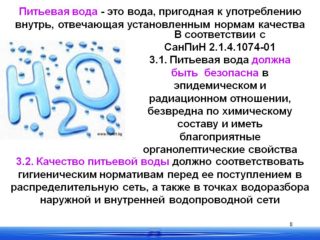Tap water should not harm the human body. Talking about its benefits, having rusty dirty pipes available, is not at all necessary. Most people prefer to boil, stand, freeze water before drinking, or insist on beneficial minerals such as silicon or shungite. But ideally you don't need to. Healthy water should contain salts, be capable of oxidation, and improve well-being and health in general.
Why is drinking water testing needed?
People in high-rise buildings pay for communal services, including water, so they have the right to quality services, but in most cases these are just empty words. Modernization of urban water supply requires a lot of money, including wastewater treatment before reuse. Therefore, people themselves must take care of their health.
An assessment of the quality of drinking water is needed in order to choose the right filter. Some indicators can only be determined by laboratory methods. Others, such as color, haze, are visible to the naked eye. This indicates that something is wrong with the source.
Key quality indicators
- turbidity due to the ingress of effluents into drinking water, as well as the presence of silicic acids, silt;
- transparency - determined by the ability to read text or see an object through a liquid in a glass;
- color is one of the most important indicators, which depends on the location of the source, the presence of iron compounds, humates or fulvic acids in it;
- smell - also depends on the presence of solutes in the liquid, it may indicate unsuitability for ingestion.
Chemical indicators:
- The number of hydrogen ions. With a large number of positively charged ions, the liquid is considered acidic, with negatively charged ions, alkaline. If the quantity is equal, it is neutral. All tap liquids are acidic, which affects human health. It has been proven that neutral or alkaline water is beneficial for the body - cancer cells and parasites cannot multiply in an alkaline environment.
- Hardness - due to the presence of elements such as calcium and magnesium. You can reduce it by boiling or filtering.
- Nitrogen - signals the ingress of ammonia from wastewater into the source. Another way is chemical fertilizers from fields or vegetable gardens. Strongly oxidizes the water in the source.
- Hydrogen sulfide - gives the liquid an extremely unpleasant smell, like rotten eggs. Has destructive properties - capable of damaging building materials such as concrete and brick.
- Sulfuric acid salts enter the soil in the form of fertilizers, which are washed out by rains into the lower layers and pass into the groundwater.
- Oxygen - Benefit is determined by the amount dissolved.
The main ways of penetration of infection into the human body are airborne droplets or through a liquid. Cholera, hepatitis, typhoid fever, fever could destroy entire cities in a short time until measures were taken to monitor the sources of water intake.
The water can contain such dangerous bacteria as E. coli and Pseudomonas aeruginosa, Staphylococcus aureus, other types of colymorphic microorganisms that live in the lower intestines of domestic animals or humans. According to the documents regulating the quality of water, they should not be in the drinking liquid.
Parasitological control is aimed at identifying and eliminating helminth cysts, lamblia, clostridia, ciliates in water bodies.
If liquid enters the house from an open source, it must be boiled. Another option is to use membrane filtration technologies that keep microorganisms out of the drinking water.
Sanitary norms and documents regulating quality
Sanitary rules and regulations, abbreviated as SanPiN, regulate the quality of the liquid supplied to the consumer. In theory, a person should not worry about his health, using tap water without prior preparation. Perhaps, at the time of leaving the water treatment systems, the quality meets all standards, but after passing through the city pipeline, the liquid ceases to be useful. It's all about old iron pipes, in which colonies of microorganisms that produce toxins function, as well as deposits of minerals on the walls, which change the chemical composition of the liquid.
In the standard indicators there are criteria that determine the amount of heavy metals, hardness elements, nitrates, oil products, arsenic, cyanides and other elements for a certain volume of liquid. The pH level for drinking water is also indicated.
Methods for testing the quality of drinking water
The ORP meter is designed to measure the amount of negatively charged hydrogen ions. Useful is a fluid that has a lower index than the ORP of the body's fluid. In this case, we can talk about the antioxidant properties of water. Wherein:
- aging processes slow down;
- the body gets rid of toxins;
- immunity increases.
It is important to properly calibrate the instrument before use. After taking measurements for a day, immerse the sensor in distilled water.
A pH meter allows you to determine the acidity level. For the body, acceptable values are from 7 to 9 units. A score below 7 is considered unfavorable. For comparison: Coca-Cola has an indicator of 4.5-5 units - this drink should not be consumed in large quantities, as it causes premature damage to teeth and bones. To neutralize cola, the body is forced to release a large amount of calcium ions in order to assimilate this product. Spring or melt water, as well as ionized coral sand, has a high pH. Such a liquid reduces the overall acidity level in the human body and promotes its self-healing.
Salt meter is a device for determining the chemical composition of a liquid. The amount of dissolved compounds depends on the region and soil composition. The device will come in handy in the process of choosing a filter for everyday use. The membrane in the reverse osmosis filter is very sensitive to the concentration of salts, so the indicator of the device can be used to select a multi-stage purification system.
In Russia, the permissible level of salt content is 1000 mg / l. In the United States, this figure is half that.












